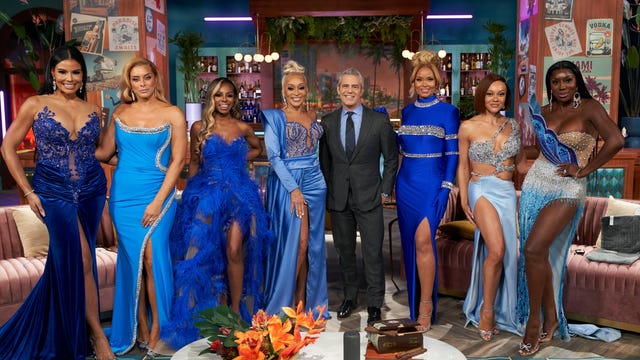Technologies
Best Streaming Services for Reality Shows: Paramount Plus, Peacock and More
Want to know how to stream your favorite reality TV shows on demand? Here’s a roundup.

Reality shows are known to jump-start careers, break hearts and turn ordinary people into household names. They can also serve as springboards for businesses (Shark Tank) or as adventures in scouting antiques (Pawn Stars). It’s likely you’ve watched at least one reality show in the past 20 years. Everyone has.
As a fan of the genre, you may regularly turn to specific channels to catch the latest installment of your favorite series. While Apple TV Plus or HBO Max — two brands known for prestige television — aren’t necessarily our first choices for getting your reality fix, plenty of other streaming services deliver the reality goods. Sometimes, though, it’s a challenge to keep up with all the shows and reality stars you’re interested in seeing.
Whether you watch reality shows for entertainment, design inspiration or educational purposes, these services offer enough to cover your tastes. Just be aware that not every season of your favorite show may be available to stream.
Read more: HBO Max to Max: New Subscription Plans Compared
Paramount Plus houses a wide variety of reality shows from CBS, VH1 and more. You can stream older and newer seasons of MTV shows such as Jersey Shore, The Challenge and The Hills. VH1 mainstays like RuPaul’s Drag Race and Love & Hip Hop are streaming on the platform, along with the popular CBS hits Survivor and Big Brother.
Paramount Plus also has a few reality originals, including The Real World: Homecoming and RuPaul’s Drag Race All Stars. Fans will also find titles from CMT (The Last Cowboy) and Paramount Network releases such as Lip Sync Battle, Ink Master and Bar Rescue. Because there’s a designated «Reality» tab on Paramount Plus, it’s easy to find each title in one central location.
The service costs $5 per month for the ad-supported version and $10 a month for ad-free.
A giant in the realm of unscripted programming, Discovery Plus is home to some of the genre’s most recognized brands. HGTV, Food Network, Discovery, TLC, Travel Channel, Magnolia Network, Animal Planet, ID, Lifetime and several others are part of the service. In total, there are 14 networks with content on Discovery Plus, which we laid out in a list here. In May, viewers will find Discovery favorites on Max, the rebranded streaming service that replaces HBO Max.
Multiple subgenres of reality TV available on the platform will have you bouncing from paranormal investigations to fishing expeditions to foodie competitions. And if you’re into celebrities like the Kardashians, Tony Hawk or Martha Stewart, they show up as guests, clients and contestants on various networks.
90 Day Fiancé fans can stay up to date with every episode of all the franchise’s spinoffs. Viewers can also stream every iteration of House Hunters and Flip or Flop, as well as follow Chip and Joanna Gaines’ offerings from HGTV to Magnolia Network. Discovery Plus also has exclusive originals like 90 Day: The Single Life and Ghost Adventures: House Calls.
As with other services, however, some seasons are missing for certain shows. Married at First Sight has 16 seasons, but only five are available on Discovery Plus. Searching is easy, and you can click on a network or type in a title or cast member’s name to find a series.
At $5 a month, Discovery Plus is a bargain for those who love to skip around the reality TV landscape. Scroll through gold mining ventures, alien research and custom motorcycles along with cupcake tutorials and educational romps with dogs.
Peacock offers NBC’s reality slate, including primetime favorites The Voice and America’s Got Talent, but that’s not all. Bravo’s conveyor belt of unscripted series lives on Peacock too, with hits like The Real Housewives franchise, Top Chef, Married to Medicine, Below Deck and Project Runway. Digging around, I again found that not every show is currently available to binge. For example, there are only three seasons of Project Runway on Peacock now.
Fox’s reality picks are also on the platform, including Hell’s Kitchen, Divorce Court, MasterChef and The Masked Singer. Shows from entertainment channel E! such as Botched can be streamed here too. What about originals? The Real Housewives of Miami and Below Deck Down Under may attract fans of Bravo-lebrities, but Snoop Dogg and Maya Rudolph are just a couple of well-knowns hosting their own original Peacock reality series.
But there’s a catch with this streaming service. Peacock users with free accounts can only access a limited number of episodes. You must have one of the service’s paid subscriptions — which start at $5 a month — to watch full seasons.
Hulu harvests much of its catalog from traditional networks like ABC, Fox, E!, VH1, BET, A&E and more. But this has disadvantages. One of them is that full seasons aren’t available for every series. While it has older seasons of Lifetime shows like Married at First Sight, current seasons don’t air on Hulu, so you can’t watch episodes the next day. Since NBC moved its content to Peacock, Hulu users can no longer stream shows from Bravo and other NBCUniversal-owned networks unless you have a live TV subscription.
For Fox shows such as The Masked Singer or MasterChef Junior, however, current episodes and full seasons are both available. And you can still find popular titles in Hulu’s catalog such as Shark Tank, American Idol, Hoarders and Storage Wars, as well as Hulu originals like The Kardashians.
Hulu keeps its reality lineup well-organized with a dedicated tab on the app. For the basic $8 subscription, you can take your pick from an assortment of channels.
During the past five years, Netflix has been gradually building its platter of reality fare. Ultimate Beastmaster was its first release, but the streamer’s made an imprint in dating and cooking entertainment. The Great British Baking Show and Is It Cake? have become hits with viewers, and series such as Love Is Blind, The Circle and Too Hot to Handle often become hot topics on the internet. However, food and romance aren’t the only two areas that Netflix covers in the reality world. Home improvement, mindfulness, travel and international releases are among the categories you’ll find on the service.
Originals Selling Sunset and Bling Empire give viewers a look inside luxurious lifestyles and real estate while Floor is Lava and Bullsh*t the Game Show put a different spin on… game shows. There’s also a row of titles described as «rugged» that features jail-themed docuseries, a peek into the custom vehicle industry, or unique jobs like funeral directors. Netflix’s monthly cost — which runs from $7 up to $20 — is significantly higher than other services.
The majority of Netflix’s reality slate is made up of originals like Tidying Up With Marie Kondo and Nailed It, but a sprinkling of licensed series such as Old Enough and Tiny House Nation are also on the platform. Whatever you do, do yourself a favor and skip the dating-in-a-creature-mask weirdness of Sexy Beasts.
How we chose these reality TV streaming services
Other streaming services such as Apple TV Plus, Disney Plus, Prime and HBO Max offer high quality entertainment, but when it comes to reality TV, scope and preference is key. Though we looked at their reality rosters, the platforms on this list have large catalogs to offer for established franchises, new releases and originals.
Netflix may not be top of mind for this genre, but according to Nielsen, the streamer has found huge popularity with some of its unscripted titles. Specifically, Selling Sunset, Love is Blind and The Great British Baking Show have performed very well. For that reason, Netflix edged out rivals like Prime and Disney Plus. I also examined Parrot Analytics statistics between 2020 and 2022 and found that shows such as RuPaul’s Drag Race, Shark Tank, The Voice and Survivor are consistently in the top rankings in terms of audience demand.
Reality TV streaming services FAQs
How do I sift through the subgenres of reality TV?
It’s a matter of preference. Do you prefer cooking tutorials and competitions? Are you into rich people’s lifestyles or everyday families? What about doing deep dives into paranormal research or tough jobs? Want to root for an underdog to win? Each service on this list offers a variety of unscripted content that doesn’t just stick to one format.
Get to know each channel where mainstream staples and fan favorites like The Voice, RuPaul’s Drag Race and Food Network shows can be found. But also look up niche series related to your interests. There’s usually something for everyone, including veterinarians who specialize in dermatology and experts in urban legends and curses.
Are there any free services with reality shows?
Yes. Free streaming services Tubi, Pluto and Crackle have a selection of reality TV series if you’re in the mood for older or newer releases. Tubi carries Real Housewives offshoots set in Vancouver, Sydney and Durban along with Fear Factor, Beat Shazam, Gordon Ramsay’s series and 2022’s Joe Millionaire. Scroll through Tubi’s reality tab to see its entire catalog.
Pluto also has a dedicated reality section where you can stream shows like Operation Repo, Jersey Shore, Storage Wars or Rescue 911. Crackle has a string of recognizable and obscure titles such as Kitchen Nightmares, The Mediator (2022) and Celebrity Sweat.
What about streaming on network sites and apps?
If you’re not watching reality TV on cable or broadcast networks, then you may wonder about streaming your shows on an app or website. But ABC, Bravo, VH1, Fox and other networks require you to sign in with a paid TV provider in order to access content on their sites and apps. ABC urges viewers to sign up for Hulu to stream anything under the brand’s umbrella. Therefore, we encourage cord-cutters to roll with one of these streaming services instead.
Technologies
Today’s NYT Mini Crossword Answers for Friday, Nov. 28
Here are the answers for The New York Times Mini Crossword for Nov. 28.

Looking for the most recent Mini Crossword answer? Click here for today’s Mini Crossword hints, as well as our daily answers and hints for The New York Times Wordle, Strands, Connections and Connections: Sports Edition puzzles.
Happy Black Friday — and that’s a fitting theme for today’s Mini Crossword. Read on for the answers. And if you could use some hints and guidance for daily solving, check out our Mini Crossword tips.
If you’re looking for today’s Wordle, Connections, Connections: Sports Edition and Strands answers, you can visit CNET’s NYT puzzle hints page.
Read more: Tips and Tricks for Solving The New York Times Mini Crossword
Let’s get to those Mini Crossword clues and answers.
Mini across clues and answers
1A clue: Major tech purchases on Black Friday
Answer: TVS
4A clue: Hit the mall
Answer: SHOP
5A clue: When many arrive at stores on Black Friday
Answer: EARLY
6A clue: «Buy one, get one ___»
Answer: FREE
7A clue: Clichéd holiday gift for dad
Answer: TIE
Mini down clues and answers
1D clue: Number of days that the first Thanksgiving feast lasted
Answer: THREE
2D clue: Small, mouselike rodent
Answer: VOLE
3D clue: Intelligence bureau worker
Answer: SPY
4D clue: Traditional garment worn at an Indian wedding
Answer: SARI
5D clue: Movement of money between accounts, for short
Answer: EFT
Don’t miss any of our unbiased tech content and lab-based reviews. Add CNET as a preferred Google source.
Technologies
Today’s NYT Connections: Sports Edition Hints and Answers for Nov. 28, #431
Here are hints and the answers for the NYT Connections: Sports Edition puzzle for Nov. 28, No. 431.

Looking for the most recent regular Connections answers? Click here for today’s Connections hints, as well as our daily answers and hints for The New York Times Mini Crossword, Wordle and Strands puzzles.
Today’s Connections: Sports Edition is a pretty tough one. If you’re struggling with today’s puzzle but still want to solve it, read on for hints and the answers.
Connections: Sports Edition is published by The Athletic, the subscription-based sports journalism site owned by The Times. It doesn’t appear in the NYT Games app, but it does in The Athletic’s own app. Or you can play it for free online.
Read more: NYT Connections: Sports Edition Puzzle Comes Out of Beta
Hints for today’s Connections: Sports Edition groups
Here are four hints for the groupings in today’s Connections: Sports Edition puzzle, ranked from the easiest yellow group to the tough (and sometimes bizarre) purple group.
Yellow group hint: Shoes.
Green group hint: Think Olympics.
Blue group hint: Kick the ball.
Purple group hint: Family affair.
Answers for today’s Connections: Sports Edition groups
Yellow group: Basketball sneaker brands.
Green group: First words of gymnastics apparatus.
Blue group: Women’s soccer stars.
Purple group: Basketball father/son combos.
Read more: Wordle Cheat Sheet: Here Are the Most Popular Letters Used in English Words
What are today’s Connections: Sports Edition answers?
The yellow words in today’s Connections
The theme is basketball sneaker brands. The four answers are Adidas, Jordan, Nike and Under Armour.
The green words in today’s Connections
The theme is first words of gymnastics apparatus. The four answers are balance, parallel, pommel and uneven.
The blue words in today’s Connections
The theme is women’s soccer stars. The four answers are Bonmatí, Girma, Marta and Rodman.
The purple words in today’s Connections
The theme is basketball father/son combos. The four answers are Barry, James, Pippen and Sabonis.
Technologies
I Love Using My Phone to Shoot Stunning Holiday Videos. Here’s How You Can, Too
These are my best tips for creating magical movies this festive season that you’ll cherish for years to come.

The iPhone 17 Pro is a superb video camera thanks to its glorious image quality, while its ease of use means it’s dead simple to quickly start shooting away. Then there’s the always fun 4K slow motion mode. Advances in mobile phone cameras mean It’s never been easier to shoot gorgeous footage of your family or your friends and the holidays are the perfect time to get creative with your videos. Don’t have an iPhone? Not to worry — other phones like the Samsung Galaxy S25 Ultra, Pixel 10 Pro or older iPhones and Android phones are also capable of capturing professional-looking video with very little effort on your part. But if you want to add some Hollywood flair to your videos, there’s a lot you can do to take things to the next level.
Read more: Best Camera Phones to Buy Right Now
It takes more than just a good camera to create videos you’ll want to watch again and again. You also need to know how to use that camera properly, how to capture the right moments and what makes for a good-looking shot. A creative eye and some planning will help too, taking you from a simple home video into something more inspiring that you’ll want to share with your family and watch again in years to come.
Don’t miss any of our unbiased tech content and lab-based reviews. Add CNET as a preferred Google source.
Here are my top tips that you should keep in mind when making your own family movies, whether you’re gathering for a holiday feast, journeying off to exotic lands on vacation or simply having some backyard drinks with friends.
1. Consider what you want your video to be
Before you start, you should give a bit of thought to what you want your video to include. While it could just be a full film of everything that happens over the holidays, or your child’s upcoming birthday, consider making it a bit more specific. Perhaps a video all about the games you play together, or them opening their presents.
Having a more focused story to tell — even a basic one — will help you consider what shots you’ll need to get, and it’ll help you shoot and edit only what you need, rather than having endless hours of footage to sift through. A Christmas day movie can be more straightforward as you’ll likely want to simply tell the story from the morning through to the drinking and games at the end of the day. Even so, try and consider how you can be selective and tell an interesting story rather than just filming every minute of the day you have together.
For my own festive-themed video (embedded above), I decided to show how I make my own hot mulled cider. By keeping it to a specific topic I was able to determine exactly the shots I needed and in what order, and even sketched out a storyboard of shots ahead of time. You don’t have to go that far, but having a rough idea in mind will help a great deal.
2. Set up your phone properly
Almost all recent smartphones can take great video, but it’s worth checking out the settings to make sure you’re ready to go. Your resolution settings are up to you, but full HD (1080p) is probably a good starting point, as it’ll look good but won’t fill up your phone’s storage too quickly. You can ramp it up to 4K if your phone allows it, or even drop it to 720p if you’re on an older device that won’t handle editing as well.
Read more: Best Camera Accessories for Your Phone
If you have an iPhone 14 Pro or later and plan on doing a lot of post-production on your footage in software like Adobe Premiere or DaVinci Resolve, you can consider shooting in Apple’s ProRes format. This gives you the best image quality, but the file sizes are immense, so if you want to keep things simple then it’s better to shoot in the standard video mode.
If you have the latest iPhone 17 Pro or previous iPhone 16 Pro you could take things further and shoot in Log. Log is a color profile that looks very low-contrast out of camera, but gives much more flexibility for adjusting the contrast, colors and overall look of the footage in post. Applying these edits is a process called color grading and it’s often what separates professional, Hollywood movies from everyday home videos. If you want to create a truly cinematic, professional look to your video, then shoot in Log and color grade your footage in DaVinci Resolve on your desktop or iPad.
It’s worth keeping an eye on your storage though, especially if you’re away from home for a while; you don’t want to fill up your space on the first two days of your trip only to have no room to capture the rest of the vacation. Those of you shooting ProRes Log on your iPhone 15, 16 or 17 Pro can now attach an SSD using USB-C for saving those huge files directly to external storage.
3. Keep your video clips short and sweet
While it’s easy to stand and film a five-minute clip of someone peeling potatoes for dinner, the reality is that when you watch that back, you’ll realize it’s way too long to remain interesting. Instead, consider keeping each clip to around 15-20 seconds in length. You might be surprised at how long 15 seconds of video actually seems like when you watch it back, and having lots of shorter clips cut together will give the video a more engaging, more professional feel.
If you’re walking up through a beautiful mountain trail, consider shooting 20 seconds of footage at 5- or 10-minute intervals — or only at particularly scenic viewpoints — rather than just filming the whole way up. But make sure you’re ready to capture interesting or funny moments as they happen as it’s these personal moments that you’ll enjoy looking back on down the line.
4. Stabilize your phone
There’s nothing that can ruin a video quite as easily as shaky hand-held footage. If your phone has a stabilized video mode, make sure it’s turned on. If not, consider using a small tripod to keep your phone steady. This of course also allows you, the filmmaker, to be involved in the action as well, which is great if you’re the one doing the cooking, or handing out presents.
You could even consider carrying a small mobile gimbal like the DJI OM 5. It allows you to get rock-steady footage even as you’re walking along, while the built-in selfie stick lets you film yourself more easily or capture more interesting angles for your footage than if you were just hand-holding your phone. If you’re interested in taking your mobile movie-making a bit more seriously then check out some of the best accessories you can pair with your phone to improve your footage.
5. Get creative with angles
A great way to improve the cinematic qualities in your film is to experiment with different angles. Say you’re capturing the moment your child takes a present from under the tree at Christmas — don’t just film them from your standing position nearby, but instead consider how you can capture that moment in a more exciting way. Perhaps even put the phone inside the tree, among the presents, so you see your child reaching toward the camera to retrieve their gift.
There’s no end to the ways you can play with your angles, so have a think about how you can shake things up. You can always try to reshoot certain things from multiple angles (or set up a spare phone or camera for another angle) and then cut them together in your video editor afterwards. In my video, for example, I wanted to show the cinnamon and ginger being thrown into the pot, so I used two angles: one from a first-person perspective looking into the pot, and another where I’d positioned my phone behind the pot to show me throwing the ingredients in. It’s little elements like this that can make a big difference overall.
6. Improve the audio and lighting
If your video will include people talking to the camera — perhaps your friends telling the camera where you are in the world or explaining how badly they’ll need a beer after the long hike — you’ll want to make sure your phone can capture that audio clearly. For the best results, consider buying a small external microphone like the Rode VideoMicro, which plugs into your phone’s power port, via an adapter, and will dramatically improve the sound quality.
Read more: Best Accessories for Better Video
If you don’t want to invest in extra gear there’s still a lot you can do to help. Turning off or at least lowering background music or closing the doors to drown out kitchen appliances will make a huge difference in how clear those voices can be captured. Outdoors, your biggest enemy for good audio will be the wind. There’s not always much you can do about it but at least trying to turn your back to the wind and providing a buffer between it and your phone will go some way to minimizing the problem.
Lighting is crucial too, and if you’re filming indoors in dimly lit spaces, then adding in your own light well help keep your footage looking good. I’ve outlined various LED light sources in my guide to video accessories, but one of my favorites for video production is the Zhiyun Fiveray FR100C light stick, which is easily hand-held and can produce any color you want, making it easy to get creative.
7. Experiment with slow motion and time lapses
Most recent phones have modes for taking slow motion video and for time lapses and both can be great tools for your video. Of course, it needs to make sense to use them — slow motion to slow down fast-paced action, and time lapse to speed up a long sequence.
In my mulled cider video, I used slow motion when lighting the stove to give a cinematic quality to the flames erupting, and I also slowed down the footage of me throwing ginger into the pot to get a great slow-mo effect on the cider splashing up. As it’s a short sequence it didn’t make a lot of sense to do a time lapse, but if you want to capture the whole process of making dinner, for example, a time lapse from high up in your kitchen, videoing you moving around over maybe a couple of hours would be a neat addition to a holiday film.
8. Edit your video
Once you have your video clips it’s time to piece them together. This can be the most challenging part, especially for those of you who are totally new to video production. Thankfully, there are easy ways of doing things.
Some phones, like the iPhones, as well as recent Samsung Galaxy phones, have built-in auto video makers that allow you to select some clips and automatically cut them together into a film, complete with background music and transitions between clips. They’re not always the most elegant of productions, but they’re worth keeping in mind if you’re a total beginner and just want a basic video put together to send to your family or friends.
Alternatively, look towards apps like BlackMagic’s DaVinci Resolve, which is free on the iPad (as well as on Mac or PC), with only some advanced features requiring a paid upgrade. It’s an incredibly well-rounded video editor that’s used by creative pros around the world and is renowned for its great tools for editing colors. For a more basic approach, look towards Quik by GoPro. It’s free and also lets you drop multiple video clips into a project for the app to automatically turn into a finished film. iPhone users will also be able to use Apple’s iMovie for free, which is an extremely easy-to-use video editor, with a variety of presets and styles available. Adobe Premiere Rush has a wide variety of editing tools and is built to be mobile friendly. It’s a great app, but it does cost $10 (£9, AU$15) a month, so it’s only worth considering if you think you’ll want to do more video production.













